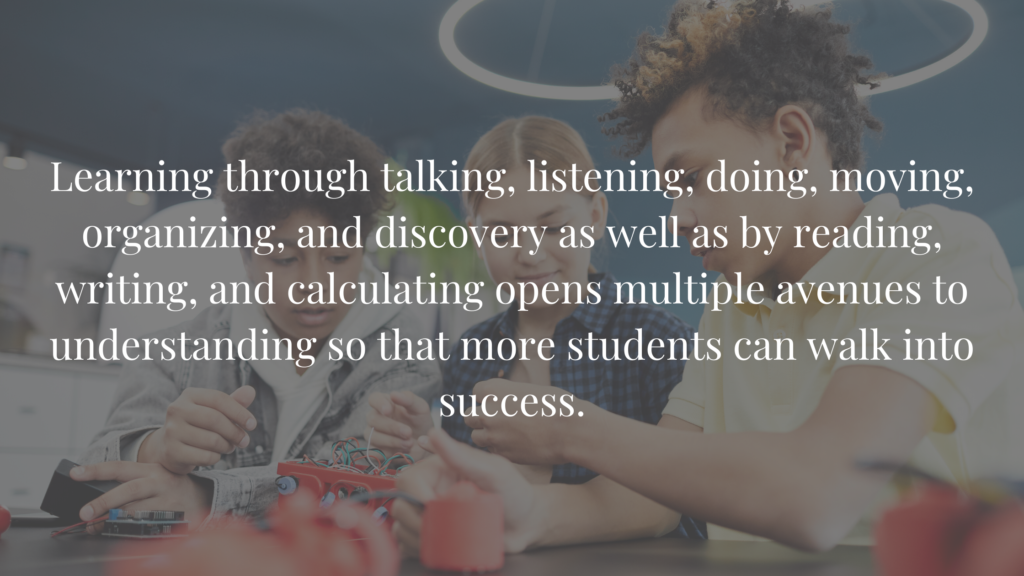The first thing you need to do, if we’re going to figure out how to let every student’s light shine in your classroom, is believe that every student is intelligent. By this I mean that you will need to let go of the perception, which is dominant in American schooling, that children who answer verbal, spatial, and mathematical questions quickly and correctly are inherently smarter than children who sing well, enjoy athletics, make excellent conversation, recognize a variety of bird calls, have a reliable sense of direction, moderate their own moods gracefully, or are inclined to thoughtful reflection. It can be tricky for teachers to avoid the pitfalls that reinforce this perception and lead students to compare themselves to one another.
An helpful alternative narrative can be gleaned from Howard Gardner’s multiple intelligences theory, in which a wider net is cast when we fish for student gifts–a net so wide that it becomes possible for educators to see, utilize, and showcase the gifts of all children.
There isn’t a single pedagogy centered on Gardner’s theory, but over the years that I’ve taught, varied instruction has helped me see and utilize my students’ myriad gifts. Doing so has made my classroom more inclusive: my broader perception of intelligence has opened more access points for academic success. My students also experience more opportunities to be appreciated and therefore elevated to a place of recognition and success in my classroom.
How It Works
Varied instruction is different from differentiation in the same way that a small restaurant’s seasonal limited-item menu is different from a Chili’s menu: there’s just a few options every day, but there’s something different every day. For example, my 7th-grade Life Science students might build a cell model one day and have a spirited discussion about how to measure osmosis with an egg another day. Sometimes we listen to dorky science rap music, and sometimes we write down what we observe. Learning through talking, listening, doing, moving, organizing, and discovery as well as by reading, writing, and calculating opens multiple avenues to understanding so that more students can walk into success. When we do each of the varied learning activities together, students can witness their peers’ varied strengths.

Why It’s About Equity
The history of IQ tests, deeply intertwined with the eugenics movement, reveals a collection of underpinning assumptions that perpetuate structural racism in schools: verbally, spatially, and mathematically precocious children are perceived to be smarter and more deserving than other children. In this paradigm, quick processers are seen as above average and can be shunted off to gifted and talented tracks, programs, and schools so that they can be prepared for eventual entrance into the ivory towers of elite higher education. In contrast, research has shown that heterogeneous classrooms serve all students better while simultaneously dismantling academic tracking, a long-standing form of institutional racism.
Discussion as a Tool for Learning
When my school detracked the science program, I suddenly had all 9th– graders in an Accelerated Biology course. During the six years that I taught this course, I introduced and maintained a series of structured discussions – one per unit – that were summative assessments impacting students’ grades. Students were only graded on their speaking and listening, although discussion preparation through reading and writing was scaffolded into the process. Many students who struggled to perform well on written examinations earned high marks in discussions. Their academic status in the class rose along with their self-esteem and sense of belonging. Other students who struggled to understand course material on their own had opportunities to learn by listening to their peers in the discussion. Two years after this program began, when the first wave of 9th-graders became 11th-graders, the enrollment in my school’s Advanced Placement science courses exploded, both in number and diversity.
Why It Matters Now
As students reenter brick-and-mortar schools after pandemic interruptions, they are seeking places of belonging. Varied instruction welcomes a wider spectrum of learners into the arena of academic success and stardom. Teachers who create many ways to experience content knowledge – speaking, listening, analysis, synthesis, experimentation, modeling, service – create diverse inclusion niches. Our students are intellectually diverse, and our course designs should be, too.
















